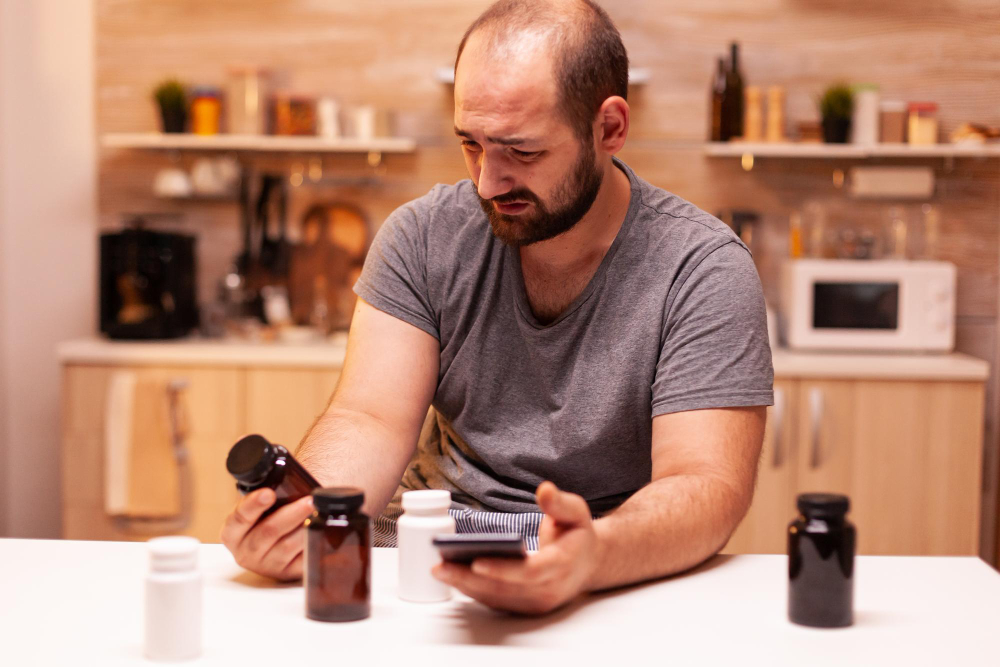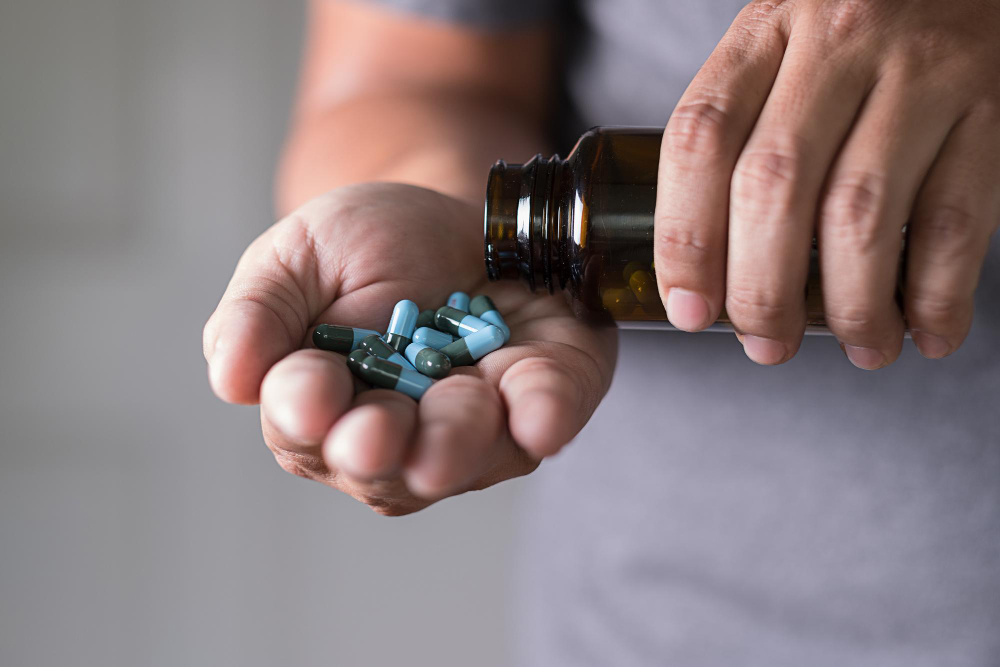
Testosterone is a vital hormone predominantly associated with male characteristics and reproductive health, although it is also present in smaller amounts in women. It belongs to a group of hormones known as androgens, which are responsible for developing and maintaining masculine traits. Testosterone plays a crucial role in several bodily functions, including:
- Development of Male Physical Characteristics: Testosterone influences the development of facial and body hair, a deeper voice, and increased muscle mass during puberty.
- Sexual Health: Testosterone is integral to libido, sexual performance, and the ability to achieve and maintain erections.
- Sperm Production: The hormone plays a vital role in sperm development, directly impacting fertility.
- Muscle Strength and Bone Health: Testosterone promotes muscle growth and strength and helps maintain bone density, reducing the risk of osteoporosis.
Produced primarily by the testicles, testosterone is essential for maintaining many aspects of health and well-being throughout a man’s life. While testosterone levels naturally decline with age, significant drops may lead to symptoms that impact quality of life and overall health, a condition known as testosterone deficiency or low testosterone.
What is Testosterone Deficiency?
Testosterone deficiency, also referred to as hypogonadism, occurs when the body is unable to produce sufficient testosterone. This can result from various factors, including aging, medical conditions, lifestyle choices, and certain medications. While testosterone levels decrease gradually after age 30, some men experience a more significant drop, leading to symptoms that warrant evaluation and treatment.
According to the National Institutes of Health (NIH), low testosterone affects millions of men, particularly those over the age of 45. Recognizing the signs of testosterone deficiency and seeking appropriate medical guidance is crucial for managing symptoms and improving overall health.
Causes of Low Testosterone
Several factors contribute to low testosterone levels, including natural aging and specific health conditions. Understanding these causes helps in identifying those at risk and exploring preventive measures.
1. Aging
Testosterone production naturally declines with age, decreasing by about 1% per year after age 30. While this gradual decline is normal, some men experience a more pronounced reduction, which can lead to symptoms of testosterone deficiency. By age 60, approximately 20% of men have low testosterone levels, according to the National Institute on Aging (NIA).
2. Medical Conditions
Certain medical conditions affect testosterone production or reduce the body’s ability to produce testosterone, including:
- Obesity: Excess body fat, particularly around the abdomen, is linked to lower testosterone levels and can impact hormone balance.
- Diabetes: Type 2 diabetes is associated with lower testosterone levels, partly due to insulin resistance and metabolic changes.
- Chronic Illness: Conditions like chronic kidney disease, liver disease, and HIV/AIDS can contribute to low testosterone levels.
- Hormonal Disorders: Pituitary gland disorders, such as hypopituitarism, interfere with hormone production and reduce testosterone.
- Autoimmune Conditions: Some autoimmune disorders can damage the testes, affecting hormone production.
3. Lifestyle Factors
Lifestyle choices also play a role in testosterone levels:
- Alcohol and Drug Use: Excessive alcohol consumption and drug use can harm testosterone production.
- Sedentary Lifestyle: Lack of physical activity and excessive sitting can lower testosterone over time.
- Sleep Disorders: Poor sleep quality, including conditions like sleep apnea, has been shown to reduce testosterone levels.
4. Medications
Certain medications, such as opioids, corticosteroids, and chemotherapy drugs, may lower testosterone levels. If a medication impacts testosterone, doctors may explore alternative treatments or address the deficiency with supplementation.
For more information on the causes of low testosterone, consult resources from the Centers for Disease Control and Prevention (CDC).
Symptoms of Low Testosterone
Symptoms of low testosterone can affect physical, mental, and sexual health. The severity of symptoms varies, depending on how low the testosterone levels are and how quickly they decline.
Physical Symptoms
- Fatigue and Low Energy: Persistent tiredness and reduced stamina are common in men with low testosterone.
- Decreased Muscle Mass and Strength: Testosterone helps build muscle, so lower levels can result in muscle weakness or a decrease in muscle mass.
- Weight Gain: Low testosterone is associated with weight gain, particularly around the abdomen.
- Loss of Body and Facial Hair: Reduced testosterone can lead to thinning body and facial hair.
- Bone Weakness: Men with low testosterone are at a higher risk for osteoporosis and fractures due to decreased bone density.
- Hot Flashes: Similar to those experienced by menopausal women, men may have episodes of sudden warmth and sweating.
Sexual Symptoms
- Low Libido: Testosterone deficiency often leads to a reduced interest in sexual activity, affecting libido and intimacy.
- Erectile Dysfunction: Difficulty achieving or maintaining erections is a common symptom, as testosterone plays a role in stimulating sexual function.
- Decreased Sperm Production: Testosterone impacts sperm production, and low levels may contribute to fertility issues.
Mental and Emotional Symptoms
- Mood Changes: Low testosterone can lead to irritability, mood swings, and feelings of sadness or depression.
- Difficulty Concentrating: Mental fog, difficulty focusing, and reduced memory can occur due to testosterone deficiency.
- Decreased Motivation: Reduced motivation or a lack of enthusiasm for activities may result from hormonal imbalance.
For a more detailed look at testosterone deficiency symptoms, visit the National Institute of Mental Health (NIMH).
Diagnosing Low Testosterone
Diagnosing testosterone deficiency involves a combination of symptom evaluation, physical examination, and laboratory tests. The diagnosis process is essential for distinguishing testosterone deficiency from other conditions with similar symptoms.
1. Medical History and Symptom Assessment
Healthcare providers begin by reviewing the patient’s symptoms, medical history, and any factors that may contribute to low testosterone. Understanding lifestyle, medication use, and any chronic health issues helps guide further testing.
2. Physical Examination
A physical exam assesses muscle mass, body hair, and any visible signs of low testosterone. Doctors may also check for conditions such as obesity or high blood pressure, which are linked to testosterone deficiency.
3. Blood Tests
Blood tests measure total testosterone levels, typically in the morning when levels are highest. Free testosterone levels, which represent testosterone not bound to proteins in the blood, may also be measured. According to the U.S. Food and Drug Administration (FDA), a testosterone level below 300 ng/dL is generally considered low in adult men, though this threshold can vary based on age and health status.
Additional hormone tests, such as luteinizing hormone (LH) and follicle-stimulating hormone (FSH), may help identify if the deficiency originates from the testicles or the pituitary gland.
Treatment Options for Low Testosterone
Treatment for testosterone deficiency varies depending on the cause, symptoms, and individual health. Options may include lifestyle changes, hormone replacement therapy, and addressing underlying medical conditions.
1. Lifestyle Modifications
Making certain lifestyle changes can help improve testosterone levels naturally:
- Regular Exercise: Strength training and high-intensity interval training (HIIT) are particularly effective for increasing testosterone levels.
- Healthy Diet: A diet rich in protein, healthy fats, and complex carbohydrates can support hormonal health.
- Adequate Sleep: Good sleep hygiene, including 7-8 hours of quality sleep per night, is essential for maintaining testosterone levels.
- Weight Management: Achieving a healthy weight helps reduce testosterone deficiency related to obesity and metabolic conditions.
2. Testosterone Replacement Therapy (TRT)
TRT is commonly prescribed for men with symptomatic low testosterone levels that cannot be improved through lifestyle changes alone. TRT aims to restore testosterone to a normal range, improving symptoms like low energy, libido, and muscle mass.
- Types of TRT:
- Gels and Creams: Applied to the skin, these products deliver testosterone through absorption.
- Injections: Intramuscular or subcutaneous injections provide controlled doses of testosterone.
- Patches: Worn on the skin, testosterone patches provide a steady hormone release.
- Pellets: Implanted under the skin, pellets offer long-term testosterone release for several months.
TRT has been shown to improve quality of life in many men, but it also carries potential risks and side effects, such as increased red blood cell count, sleep apnea, and prostate issues. Regular monitoring is essential to ensure safety and efficacy. For more on TRT, visit the National Institute on Aging (NIA).
3. Addressing Underlying Conditions
If a medical condition such as obesity, diabetes, or a pituitary disorder is causing low testosterone, treating that condition may improve testosterone levels. For instance, weight loss, blood sugar control, and managing other metabolic issues can positively impact hormone balance.
4. Alternative Medications
In some cases, medications such as clomiphene citrate or hCG (human chorionic gonadotropin) are used to stimulate testosterone production in the testicles, particularly for men who wish to maintain fertility.
Risks and Considerations of Testosterone Therapy
While testosterone therapy can significantly improve quality of life, it’s important to understand potential risks. TRT may not be suitable for all men, especially those with certain medical conditions. Potential risks include:
- Increased Risk of Prostate Cancer: While research is mixed, some studies suggest that TRT may accelerate the growth of existing prostate cancer.
- Cardiovascular Risks: TRT may increase the risk of blood clots, stroke, and heart attack, particularly in older men.
- Sleep Apnea: Testosterone therapy may worsen sleep apnea, a sleep disorder that can affect cardiovascular health.
Men considering TRT should discuss risks and benefits with a healthcare provider and undergo regular monitoring to ensure safety.
Living with Testosterone Deficiency
Managing testosterone deficiency involves a combination of medical treatment, lifestyle changes, and regular monitoring. Here are some additional tips for living with low testosterone:
- Regular Checkups: Frequent follow-ups help monitor hormone levels, assess therapy effectiveness, and detect potential side effects.
- Mental Health Support: Low testosterone can impact mood and mental health. Seeking counseling or support groups can be beneficial.
- Communication with Partners: Low libido and other symptoms can affect relationships. Open communication with partners helps maintain understanding and support.
For further resources on living with low testosterone, refer to the National Institutes of Health (NIH).
Conclusion
Low testosterone, or testosterone deficiency, can impact a man’s quality of life, affecting physical, sexual, and mental health. Understanding the symptoms, causes, and treatment options is essential for managing the condition effectively. Whether through lifestyle modifications, testosterone replacement therapy, or addressing underlying health issues, men experiencing symptoms of low testosterone have options to improve their health and well-being. Consulting with a healthcare provider to explore these options and develop a personalized treatment plan is the first step toward reclaiming vitality and confidence.
For more information on testosterone deficiency and treatment options, visit the National Institutes of Health (NIH).



